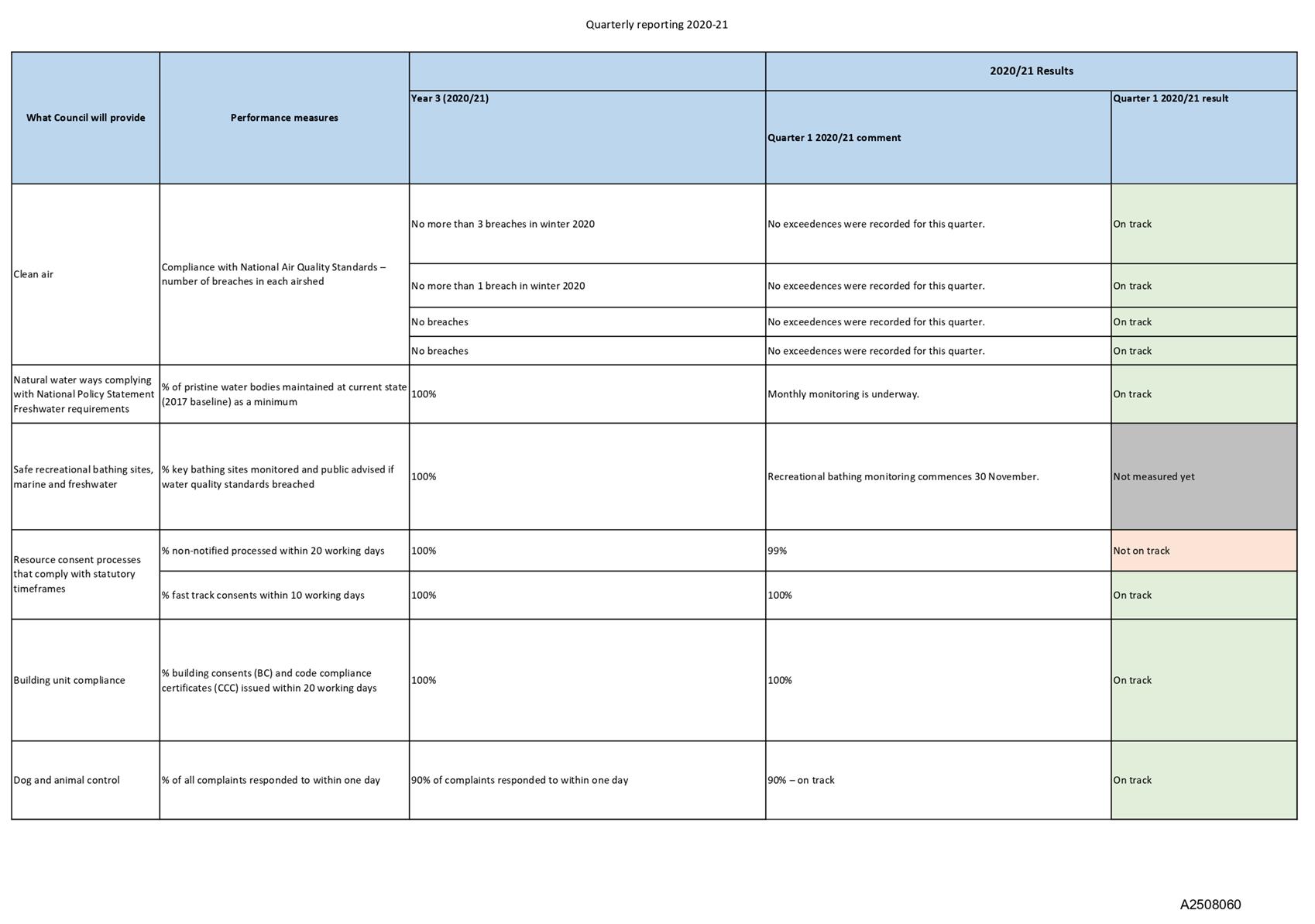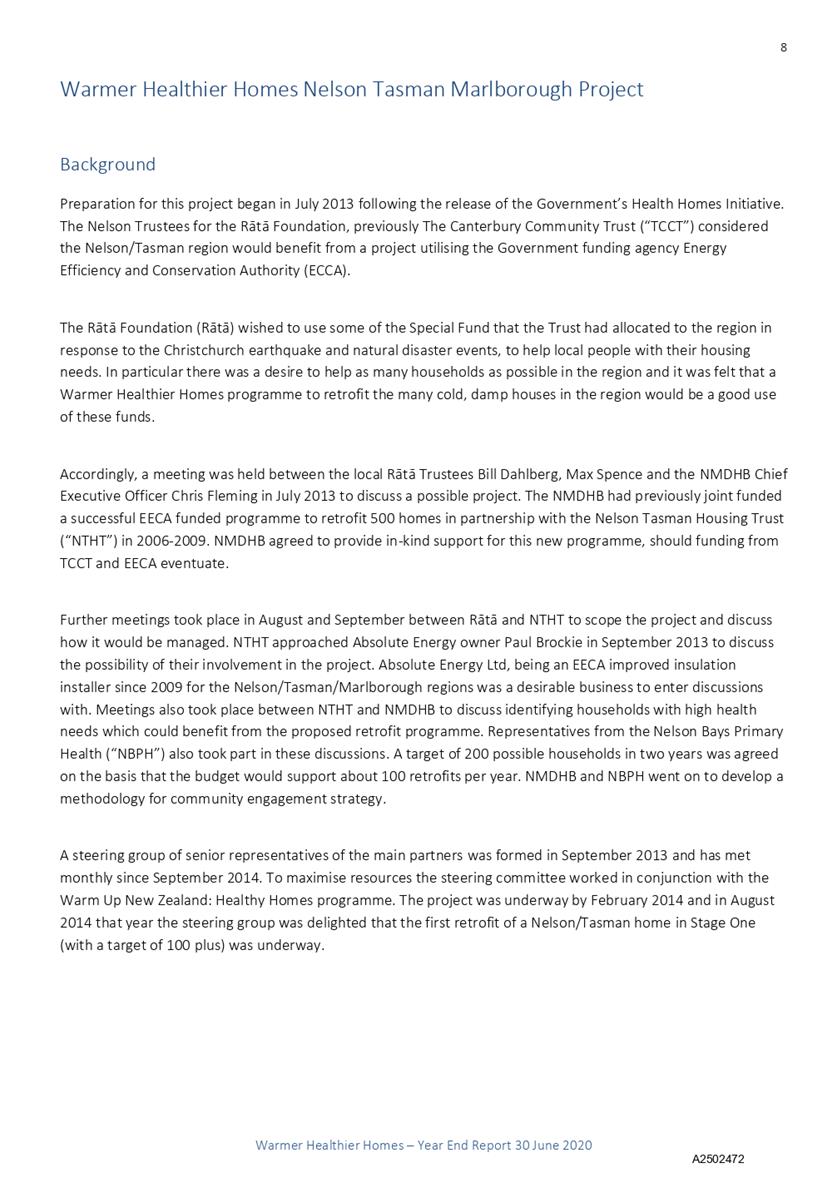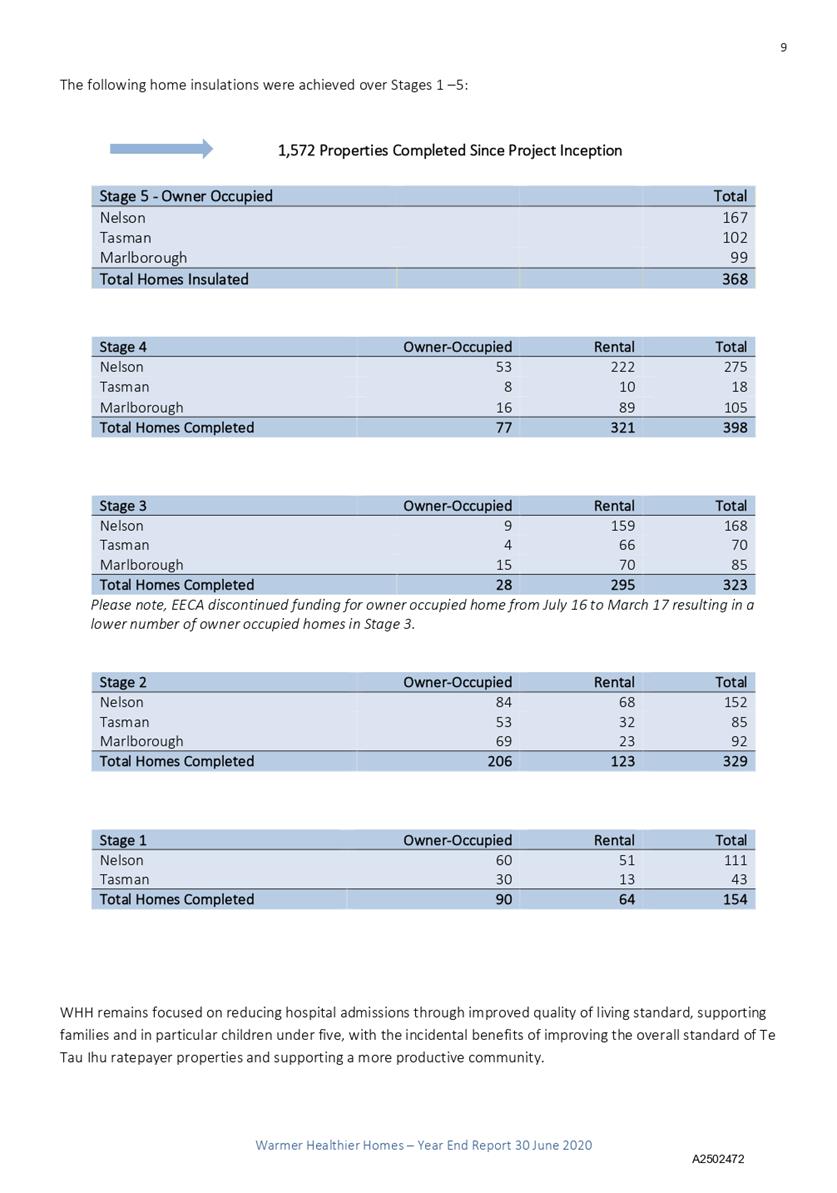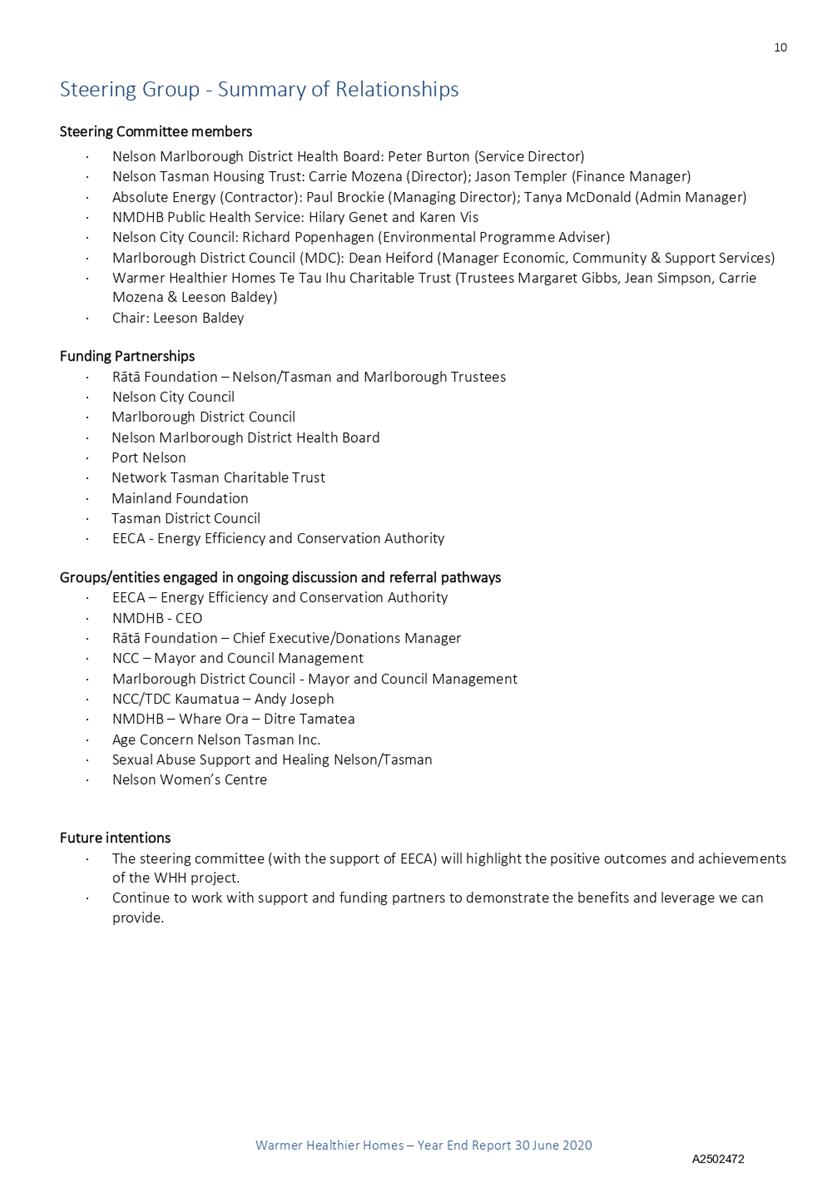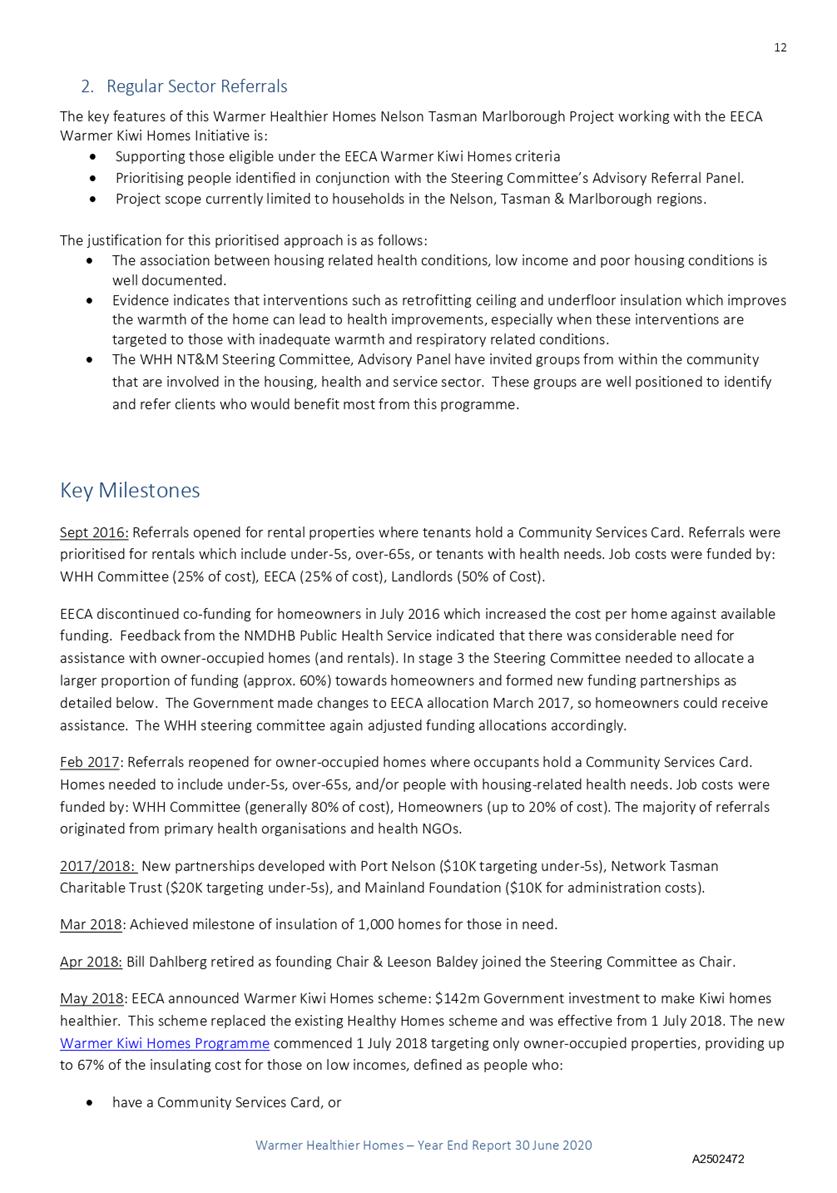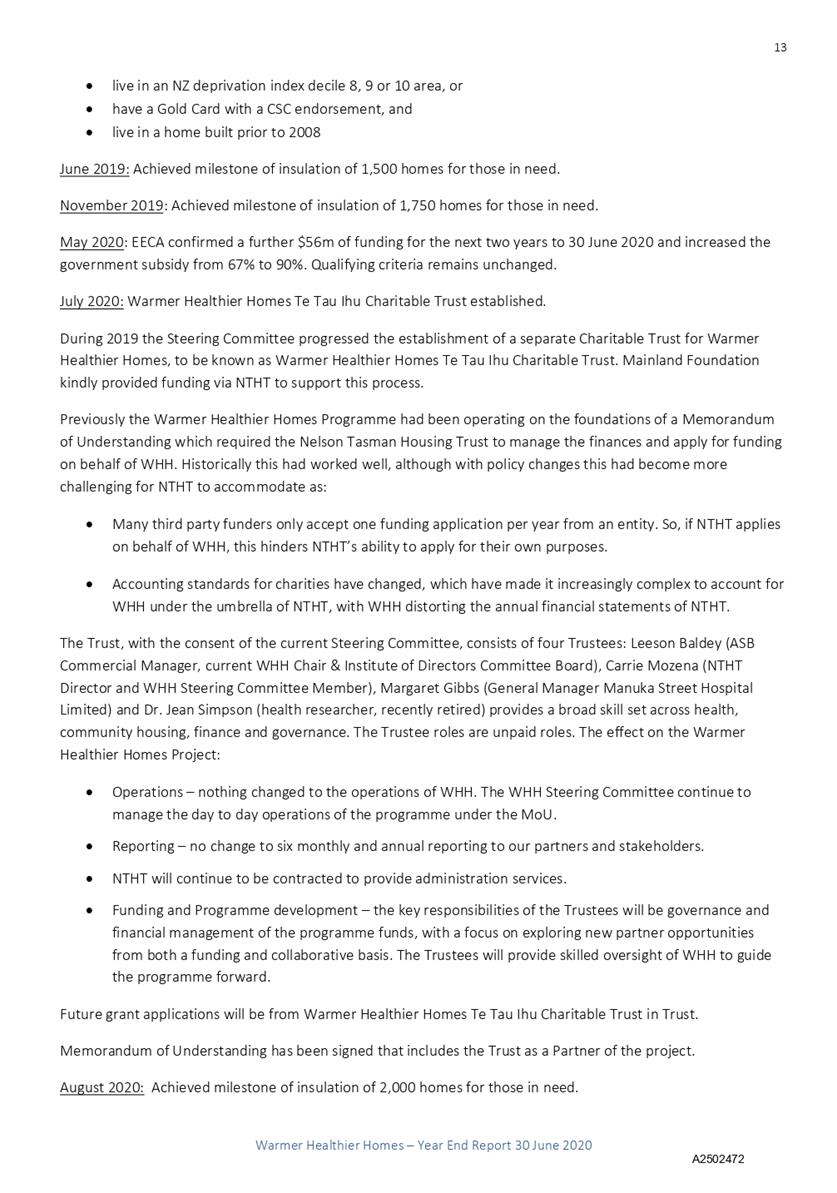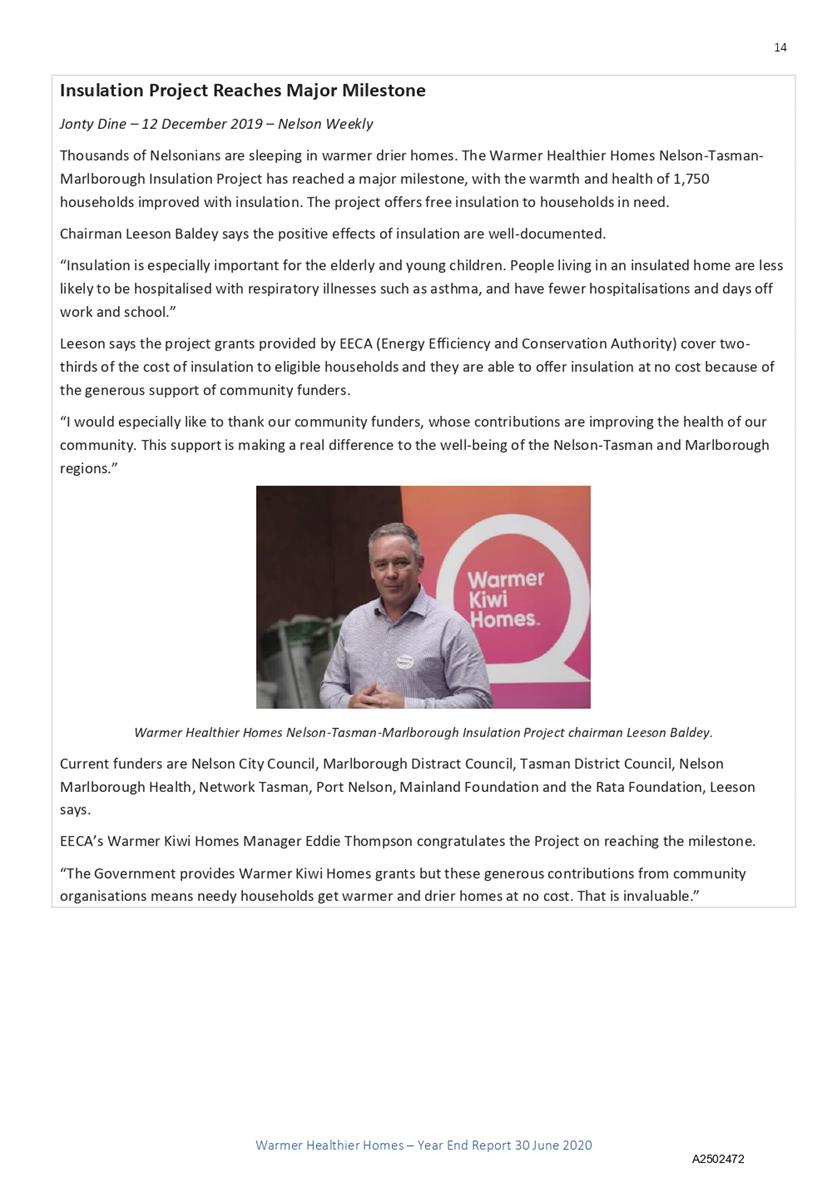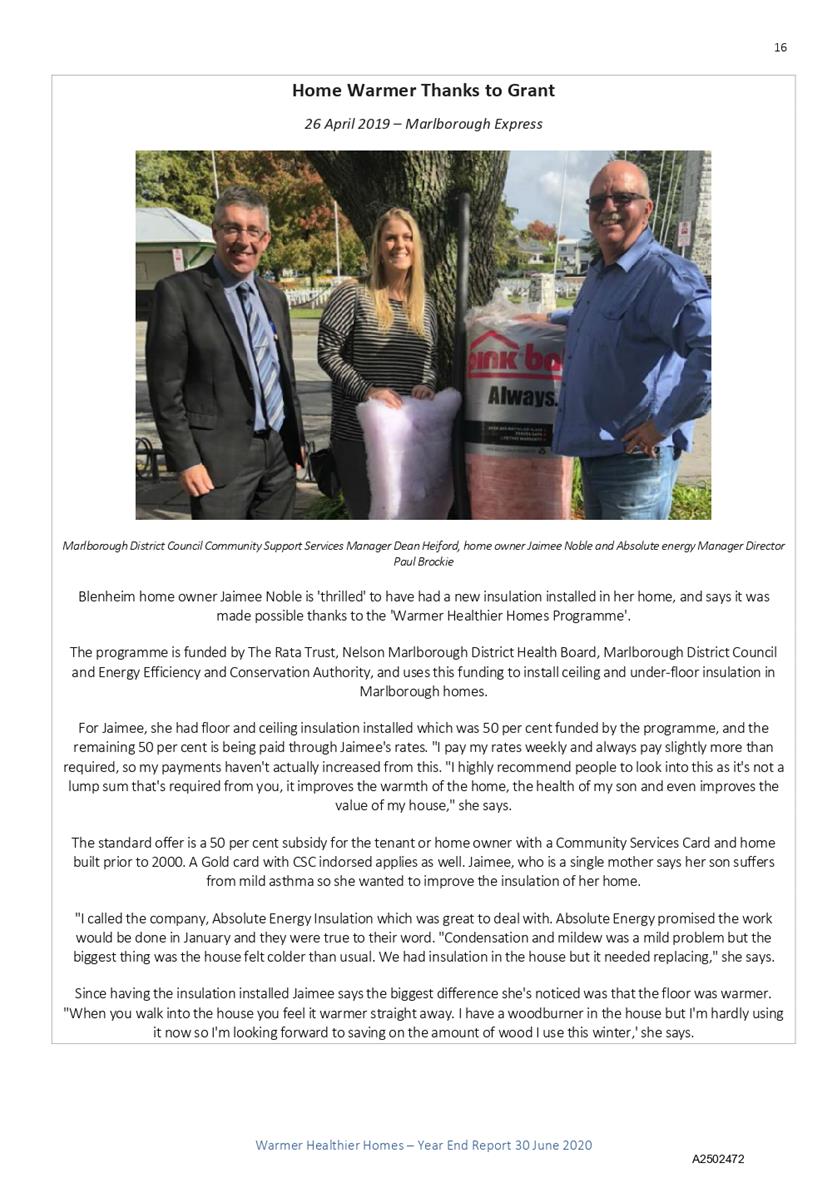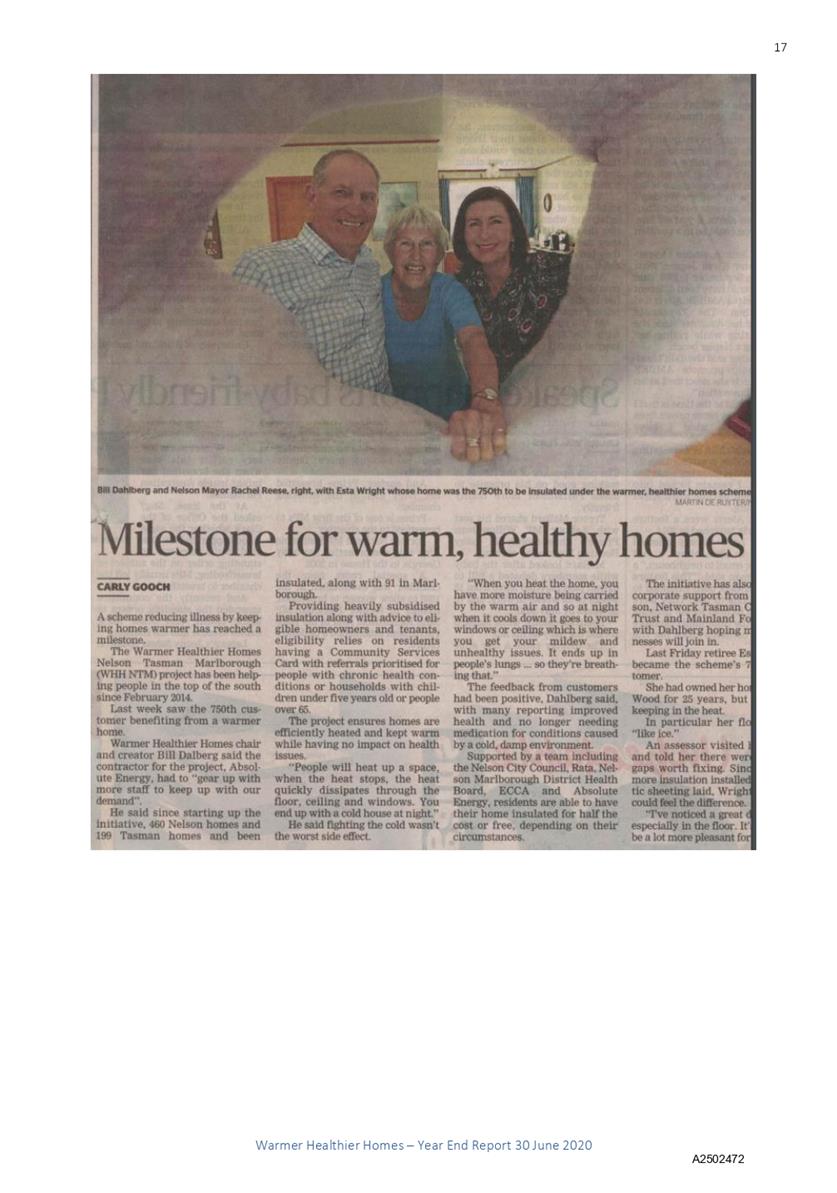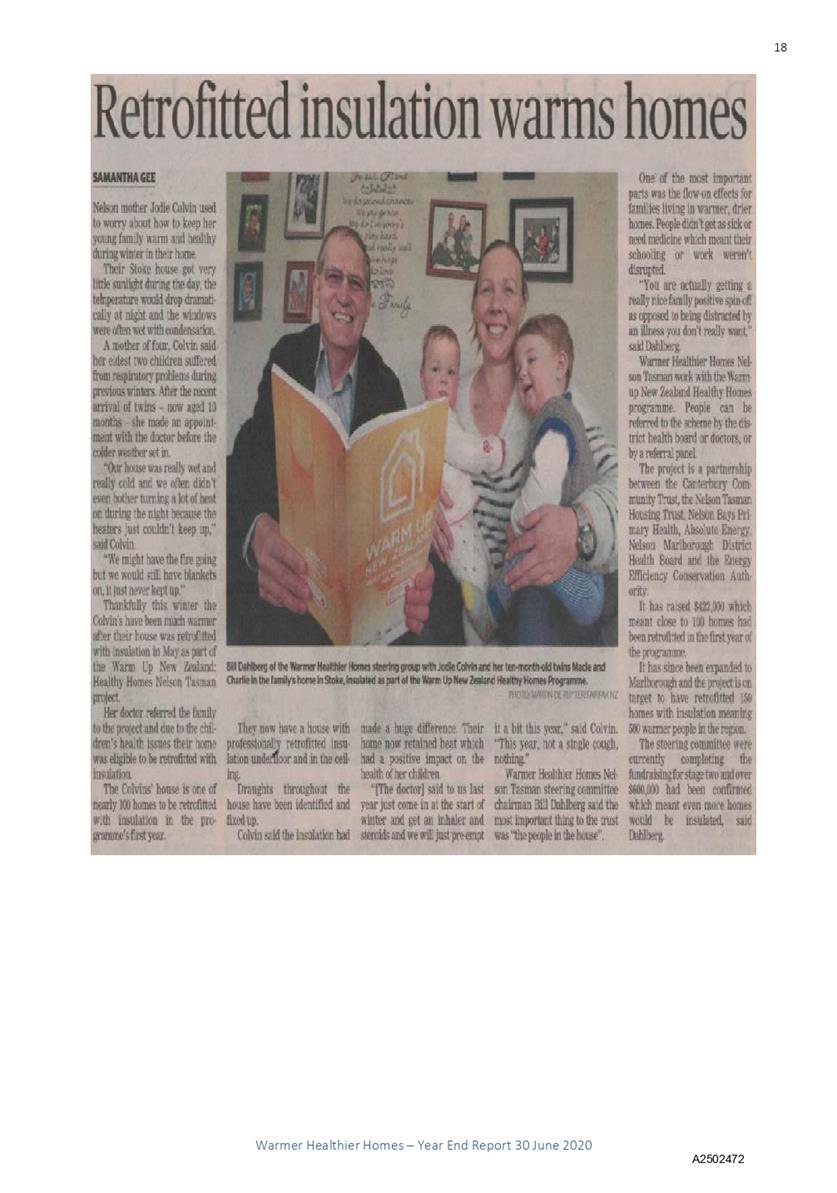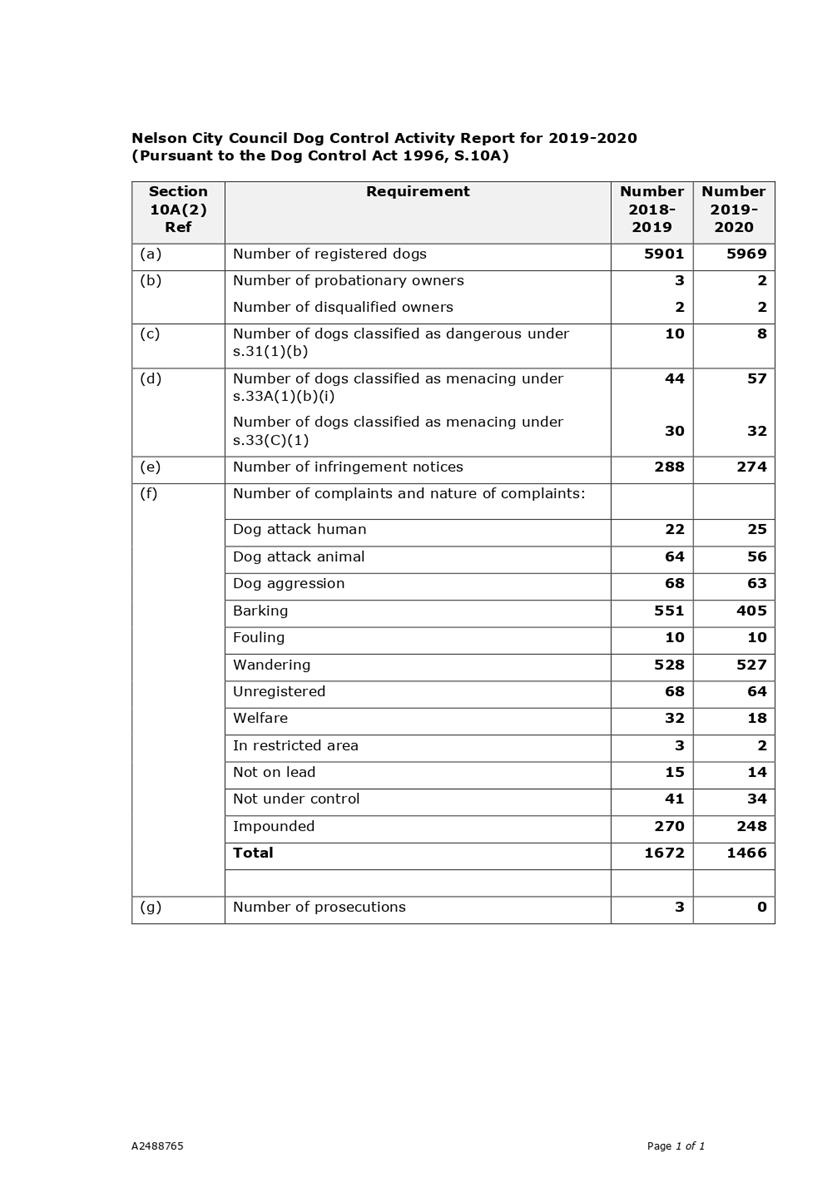Areas
of Responsibility:
·
Building control matters, including
earthquake-prone buildings and the fencing of swimming pools
·
Brook Waimarama Sanctuary Trust
·
Bylaws, within the areas of
responsibility
·
Climate Change policy, monitoring
and review
·
Climate change impact and strategy
overview - mitigation, adaptation and resiliency
·
Climate change reserve fund use
·
Environmental programmes including
(but not limited to) warmer, healthier homes, energy efficiency, environmental
education, and eco-building advice
·
Environmental regulatory and
non-regulatory matters including (but not limited to) animals and dogs,
amusement devices, alcohol licensing (except where delegated to the Alcohol
Regulatory and Licensing Authority), food premises, gambling, sugar-sweetened
beverages and smokefree environments, and other public health issues
·
Environmental science monitoring
and reporting including (but not limited to) air quality, water quality, water
quantity, land management, biodiversity, biosecurity (marine, freshwater and
terrestrial), pest and weed management, and coastal and marine science
·
Environmental Science programmes
including (but not limited to) Nelson Nature and Healthy Streams
·
Hazardous substances and
contaminated land
·
Maritime and Harbour Safety and
Control
·
Planning documents or policies,
including (but not limited to) the Land Development Manual
·
Policies and strategies relating to
compliance, monitoring and enforcement
·
Policies and strategies related to
resource management matters
·
Pollution control
·
Regulatory enforcement and
monitoring
·
The Regional Policy Statement,
District and Regional Plans, including the Nelson Plan
·
Urban Greening Plan
Delegations:
The
committee has all of the responsibilities, powers, functions and duties of Council
in relation to governance matters within its areas of responsibility, except
where they have been retained by Council, or have been referred to other
committees, subcommittees or subordinate decision-making bodies.
The
exercise of Council’s responsibilities, powers, functions and duties in
relation to governance matters includes (but is not limited to):
·
Monitoring Council’s
performance for the committee’s areas of responsibility, including
legislative responsibilities and compliance requirements
·
Developing, monitoring and
reviewing strategies, policies and plans, with final versions to be recommended
to Council for approval
·
Developing and approving draft
Activity Management Plans in principle, for inclusion in the draft Long Term
Plan
·
Reviewing and determining whether a
bylaw or amendment, revocation or replacement of a bylaw is appropriate
·
Undertaking community engagement,
including all steps relating to Special Consultative Procedures or other formal
consultation processes other than final approval
·
Approving submissions to external
bodies or organisations, and on legislation and regulatory proposals
·
Approval of increases in fees and
charges over the Consumer Price Index (CPI)
Powers
to Recommend to Council:
In
the following situations the committee may consider matters within the areas of
responsibility but make recommendations to Council only (in accordance with
sections 5.1.3 - 5.1.5 of the Delegations Register):
·
Matters that, under the Local
Government Act 2002, the operation of law or other legislation, Council is
unable to delegate
·
The purchase or disposal of land or
property relating to the areas of responsibility, other than in
accordance with the Long Term Plan or Annual Plan
·
Unbudgeted expenditure relating to
the areas of responsibility, not included in the Long Term Plan or Annual
Plan
·
Approval of notification of any
statutory resource management plan, including the Nelson Plan or any Plan
Changes
·
Decisions regarding significant
assets
·
Actions relating to climate change
not otherwise included in the Annual Plan or Long Term Plan
·
Approval of final versions of
strategies, policies and plans
Item 7: Port and
Harbour Safety Management System
|

|
Environment and Climate Committee
1 December 2020
|
REPORT R21423
Port
and Harbour Safety Management System
1. Purpose
of Report
1.1 To
consider the recent joint self-assessment of Nelson’s Port and Harbour
Safety Management System. Nelson’s harbourmaster (Andrew Hogg), will
attend the meeting to assist with the Committee’s consideration.
2. Recommendation
|
That the Environment and Climate Committee
1. Receives
the report Port and Harbour Safety Management System (R21423) and its attachments (A1418392 and
A2474992); and
2. Notes further updates will be
provided to the Environment and Climate Committee as actions are undertaken
to address the identified gaps in the Port and Harbour Safety Management
System.
|
3. Background
3.1 Navigation
safety is a regional council responsibility. Nelson City Council has an
agreement with Port Nelson Ltd to undertake the harbourmaster duties on
Council’s behalf. The agreement identifies duties and responsibilities
for both the Nelson Harbour and wider harbour areas (including navigation
safety).
3.2 The
New Zealand Port and Harbour Marine Safety Code (the Code) provides best
practice guidance on the safe management of marine activities in ports and
harbours. Established in 2004 by Maritime NZ, the Code is voluntary and every
regional council and port operator across New Zealand has undertaken to comply
with it. The Code sets out the legislation, safety policies, risk assessments
and the development of an active safety management system (SMS) for both the
harbour and port operators.
3.3 The
SMS is to contain systems that address the risks for the Port operator and the
wider harbour to ensure the harbour is safe for all users. The Nelson Port and
Harbour Marine Safety Code covers both the port and harbour aspects with a
focus on the port operations (see Attachment 1 for the 2015 Nelson Port and
Harbour Marine Safety Code).
3.4 The
Code recommends a separate Port SMS and Harbour SMS to show clear delineation
of responsibilities, functions and risks being held by the port and those being
held by the regional council. The operation of safety management systems cover
implementation of good practice for the following topics:
• hydrography
• prevailing conditions
• aids to navigation
• anchorages
• wrecks
• works in harbours
• vessel traffic
services
• passage planning and
guidance
• pilotage and pilotage
exemptions
• marine services
• tugs
• berthing
• dangerous goods and
harmful substances
• emergency response and
• marine pollution and
ships in distress
3.5 Nelson’s
Port and Harbour Safety Marine Code was drafted by the previous Harbourmaster,
Captain David Duncan. Captain Duncan participated in the national working group
for the Code and SMS reviews for five years as well as the risk assessment
working group. He also assisted Maritime NZ on the panel for the professional
development of pilots.
3.6 Nelson’s
Marine Safety Code documentation has not changed since 2015. Over the last five
years Nelson has seen larger ship sizes and the national Code has been updated.
Having a combined document has resulted in portions of harbour safety matters
not being specifically referenced and some of the delineation of
responsibilities is unclear.
3.7 The
SMS is reviewed annually by way of a self-assessment provided by the regional
council (harbourmaster) and the port (operations manager). Council has an
agreement with Port Nelson Limited that they employ the harbourmaster. Both the
harbourmaster role and the operations manager role are carried out by the same
person, Andrew Hogg.
3.8 Every
three to five years an external review is undertaken by a panel of Maritime NZ
officers, harbourmasters and operations managers from other regions, of the
SMS. Nelson’s external review is due to occur in February/March 2021.
3.9 Andrew
Hogg has undertaken the annual self-assessment for the year ending June 2020 of
Nelson’s SMS. Mr Hogg has been in the harbourmaster role since December
2019. He has identified some gaps in the documentation (see Attachment 2 for
full details of the assessment). These gaps include:
· The need for a
pilot training system consistent with the Maritime NZ approved Pilot
Proficiency Plan and records incorporating learnings from accident investigations.
· The need to update
the Pilotage Plan to incorporate current best practices.
· The need to
develop policies specifically for the harbour (policies are in place for the
port) and provide a harbour SMS as well as a port SMS.
· The need to conduct
a risk assessment.
· The need for wider
harbour user engagement.
· The need to update
the SMS to be consistent with the Code. The Code has changed since the SMS was
drafted.
3.10 The
self-assessment for 2019/20 has resulted in a lower rating than the previous
self-assessment for 2018/19. On a scale of one (poor) to five (excellent) the
average scores are three but there are a couple of twos recognising the gaps in
the documentation. Previous self-assessments have ranged between three and four
but noted some processes need to be updated and the in depth review of policies
and procedures was to occur every two to three years.
4. Significance
4.1 In
2015, Nelson’s Marine Safety Code was assessed as compliant with the
standards at the time. Since then there have been a significant number of
updates to the Code and general industry standards.
4.2 The
self-assessment has identified gaps in documentation, policies, procedures and
records do not demonstrate the implementation of the most recent best practice
industry standards. The existing controls to mitigate risk in the harbour
requires updating to be more consistent with current good practice standards.
4.3 Consequently
the Harbourmaster has undertaken immediate steps to address identified gaps
(outlined below) and will take further action if required following the
external review in 2021.
5. Actions
5.1 The
harbourmaster has engaged the services of a consultant to assist with
addressing the documentation gaps. Phase One of this work will be completed in
early December 2020 with the production of a Harbour Safety Plan, Harbour SMS
and a Port SMS. This will provide a safety framework for the harbour and
harbour users.
5.2 The
development of both a Harbour SMS and a Port SMS will allow for a clearer
delineation of responsibility between the roles of Harbourmaster and that of
Marine Operations Manager to better align with the Code.
5.3 Phase
Two, which commenced mid-November, is a Risk Assessment of the harbour with an
expected completion date of the end of December 2020. It is expected that there
will be additional streams of work that will be identified during this process
and the Port is committed to undertaking these. An update on progress will be
provided at the meeting.
5.4 There
is also commitment from the Port to investigate any recommendations as the
result of the external review that is to occur in February/March 2021.
Recommendations could include improving practices, procedures, policies or
systems that enable and support the safe management of marine activities for
both the port and wider harbour users.
6. Conclusion
6.1 The
annual self-assessment of the Nelson Port and Harbour Safety Management System
has identified there are gaps in the SMS and it needs to be updated to be more
consistent with the current Code and industry best practices.
6.2 Having
a single SMS for both the port and harbour has resulted in some
responsibilities and risks relating to specific areas being unclear. This is
being addressed now and further changes to the SMS may be required after the
external review.
6.3 Council
officers are working with the harbourmaster to put systems in place to ensure
Nelson’s SMS is improved and then maintained at a high standard. Progress
will be reported to the Committee.
Author: Mandy
Bishop, Manager Consents and Compliance
Attachments
Attachment 1: A1418392
Nelson Port and Harbour Marine Safety Code 2015 ⇩
Attachment 2: A2474992
Nelson Port and Harbour Safety Management System self assessment ⇩
Item 8: National Policy
Statement on Urban Development: Removal of minimum car parking rates from the
Nelson Resource Management Plan
|

|
Environment and Climate Committee
1 December 2020
|
REPORT R21447
National
Policy Statement on Urban Development: Removal of minimum car parking rates
from the Nelson Resource Management Plan
1. Purpose
of Report
1.1 To
give effect to the National Policy Statement on Urban Development
(NPS-UD) by approving the removal of Nelson Resource Management Plan
requirements for minimum on-site parking rates.
2. Recommendation
|
That the Environment and Climate Committee
1. Receives
the report National Policy Statement on Urban Development: Removal of minimum
car parking rates from the Nelson Resource Management Plan (R21447).
|
Recommendation to Council
|
That the
Council
1. Delegates to the Chair of the
Environment and Climate Change Committee and the Group Manager Environmental
Management, authority to approve the removal of Nelson Resource Management
Plan requirements for minimum on-site parking rates, including rules,
assessment criteria, policies or objectives that have the effect of setting
minimum parking rates, including consequential amendments in accordance with
s.55 of the Resource Management Act.
|
3. Background
3.1 The
National Policy Statement on Urban Development (NPS-UD) requires Councils to
remove on-site car parking rates no later than the end of 2021. The NPS-UD car
parking policies have the effect of removing minimum car parking rates from the
district plans of tier 1, 2 and 3 territorial authorities. Nelson City Council
(NCC) is a Tier 2 Council.
3.2 The
purpose of the NPS-UD is to enable more housing and commercial developments.
This is expected for higher density areas where people do not necessarily need
to own or use a car to access jobs, services, or amenities. It is intended that
the number of car parks be driven by market demand, rather than planning
requirements.
3.3 This
will enable urban space to be used for higher value purposes other than car
parking, and remove some of the costs for higher density developments.
Developers may, however, still choose to provide car parking in many
areas.
3.4 The
NPS-UD sets out the following direction for car parking.
3.4.1 Tier
2 territorial authorities must remove district plan rules, assessment criteria,
policies and objectives that have the effect of setting minimum car parking
rates.
3.4.2 Territorial
authorities must remove the provisions from their district plans without using
a public plan change process (Schedule 1 of the Resource Management Act 1991
(RMA)).
3.4.3 Territorial
authorities must amend their district plans to remove car parking minimums as
soon as practicable, no more than 18 months from the date of commencement of
the NPS-UD.
3.5 The
NPS-UD does not impact the following:
3.5.1 rules
and engineering standards that set minimum dimensions for vehicle manoeuvring
and car parking spaces when a developer chooses to supply car parks, or where
parking for vehicles other than cars is required, such as loading bays,
drop-off areas, bus, bike and other mobility parking
3.5.2 managing
the physical effects of car parking such as visual impacts, stormwater and
impacts on adjacent uses. Local authorities can continue to manage the effects
in ways such as avoiding or managing surface level or front yard parking, and
screening parking areas from adjacent activities.
3.5.3 rules
and other standards held under other statutes and regulations, such as the
Building Code as it relates to access for car parks, accessible car parking and
fire service vehicle access.
3.5.4 rules
which set the minimum rates of accessible car parks.
3.5.5 rules
which set maximum parking rates.
3.6 This
does not change how territorial authorities consider supply and demand.
Territorial authorities can continue to consider the effects of car parking
supply and demand in resource consents for discretionary or non-complying
activities.
3.7 The
NPS-UD does not affect engineering standards or the ability of territorial
authorities to provide on-street car parking spaces. The ability to consider
travel demand effects is not affected by the car parking policy, and can
continue to be managed by district plans.
4. Discussion
Nelson
Resource Management Plan (NRMP)
4.1 In
accordance with s.55 of the Resource Management Act, changes to a resource
management plan must be made to give effect to an National Policy Statement
(NPS) without a Schedule 1 process, where directed by the NPS. This means that
no public consultation, submissions or hearings can be held.
4.2 Changes
to the NRMP will only include removal of minimum parking rate requirements, and
provisions with the effect of requiring the same. The changes are expected to
affect policies, rules, appendices, assessment criteria, and consequential text
such as explanations for rules.
4.3 The
NRMP will continue to:
4.3.1 set
minimum parking rates for parking designed and marked for use by people with
mobility impairments.
4.3.2 Set
dimensions and standards for parking design; loading; surfacing;
manoeuvring/non reversing streets; gradient of parking spaces (where provided);
access design
4.3.3 Set
rules for vehicle queuing for particular activities (e.g. drive-through
activity, service stations)
Draft Nelson Plan
4.4 The
draft Nelson Plan will be amended to incorporate the NPS-UD policy directions.
These includes comprehensive parking management plans, travel demand management
and any other methods that are the appropriate means of managing the demand and
supply effects of car parking.
4.5 The
current draft Nelson Plan includes car parking rates as a guide. However,
this may change following further review and public feedback.
Implications for the
Development Contributions Policy (2018)
4.6 The
Development Contributions policy uses the Parking Rates in AP10.3 of the NRMP
to make an assessment of the transport contribution required for other than
residential development. The policy will continue to rely on the NRMP standards
that applied at the time the Development Policy was adopted to undertake this
assessment.
4.7 The
current review of the Development Contribution policy will consider an
alternative method for calculating contributions. The timing of the review
aligns with the Long Term Plan process.
4.8 The
implementation of the NPS-UD is likely to deliver the intended goal of
providing more land for housing development. However, in provincial centres the
extent of application and rate of change may be less than more urbanised areas.
This means that the demand for car parking spaces on a site may continue.
Implications for On-street
Parking
4.9 There
are also risks that unplanned demand for parking effects on-road parking and
traffic safety. These effects are to be monitored over the coming months and
consideration of these risks taken into account as Council reviews its approach
to parking management and travel demand management
4.10 No
changes to on-road parking standards contained in the Nelson Tasman Land
Development Manual are proposed via this report.
5. Options
5.1 The
Committee has two options as presented below. Officers support Option 1 and
amending the NRMP as soon as possible in line with the NPS-UD.
|
Option 1: Amend NRMP as soon
as practicable
|
|
Advantages
|
· Provides
clarity for applicants
· Reduces
resource consent applications as parking rate requirements will not trigger
the need for resource consent
· Implements
national directions as intended
|
|
Risks and Disadvantages
|
· Potential
for contention about applicability of Development Contribution policy
calculations until new Policy is adopted.
|
|
Option 2: Delay changes to
NRMP
|
|
Advantages
|
· No
risk of contention about applicability of DC policy.
|
|
Risks and Disadvantages
|
· Creates
unnecessary resource consent applications and increases development costs.
Consents for reduced parking rates are required to be approved as if they
were permitted activities.
|
6. Conclusion
6.1 The
NPS-UD requires councils to remove on-site parking rates. Section 55 of
the Resource Management Act enables Council to implement national policy
statements, where there is direction to do so, without a Schedule 1 plan change
process.
7. Next
Steps
7.1 The
NPS-UD requirements will be implemented at the earliest opportunity. The
public notification of the removal of car parking rates is anticipated in early
2021.
Author: Maxine
Day, Manager Environmental Planning
Attachments
Nil
|
Important considerations for decision making
|
|
1. Fit
with Purpose of Local Government
This report fits with the purpose of local
government as it responds to a national direction set out in the Resource
Management Act 1991. The purpose of the changes are to promote sustainable
management and contribute to the well-being of Nelson communities.
|
|
2. Consistency
with Community Outcomes and Council Policy
The implementation of the National Policy Statement
on Urban Development contributes to the following Community Outcomes:
Our
urban and rural environments are people-friendly, well planned and
sustainably managed
Our
infrastructure is efficient, cost effective and meets current and future
needs
|
|
3. Risk
There are
limited risks associated with this report. Over time an increase in parking
may occur on streets creating traffic impacts that may need consequential
management.
There are no direct financial risks associated with
this report.
|
|
4. Financial
impact
No additional funding for the implementation of the
NPS UD parking rate removal from the Nelson Resource Management Plan is
required. Resource consent applications for car parking generally require
consent for other matters. As a result there is expected to be limited
change to resource consent numbers.
|
|
5. Degree
of significance and level of engagement
This matter is of low significance because the
changes implement national directions, and the rate of change for parking is
anticipated to be relatively slow. The changes that have been made by central
government were consulted on with the public.
The Resource Management Act requires these changes
to be made with no Schedule 1 plan making process, therefore no consultation
or engagement is planned prior to making these changes.
|
|
6. Climate
Impact
The implementation of the NPS UD parking rate rule
removal has been intended to contribute to a higher density, urbanised town
centres, with greater emphasis on active transport. This is one lever
that the government is pulling to transition communities to alternative modes
of travel and to reduce the need for ‘urban sprawl’ –
thereby reducing the need for commuting and associated emissions.
|
|
7. Inclusion
of Māori in the decision making process
No engagement with Māori has been undertaken in
preparing this report.
|
|
8. Delegations
The Environment and Climate Change Committee has the
following delegations to consider the removal of minimum car parking rates
from the Nelson Resource Management Plan:
Areas of Responsibility:
· District
Plan
Delegations:
· Developing,
approving, monitoring and reviewing policies and Plans
Powers to Recommend (if applicable):
· Approval
of final versions of strategies, policies and plans
|
Item 9: Environmental
Management Quarterly Report - 1 July - 30 September 2020
|

|
Environment and Climate Committee
1 December 2020
|
REPORT R21402
Environmental
Management Quarterly Report - 1 July - 30 September 2020
1. Purpose
of Report
1.1 To
report on financial and non-financial performance measure results for the first
quarter of the 2020/2021 financial year for the Environmental Management Group
activities. The activities included are: Building, City Development,
Consents and Compliance, Planning, and Science and Environment.
2. Summary
|
Activity
|
Level
of Service Performance Measure
|
Measure
|
Achievement
– 1st Quarter
|
|
Building
|
% building consents and code
compliance certificates issued within 20 working days
|
100%
|
100% – on track
|
|
Resource Consents and
Compliance
|
% non-notified processed
within 20 working days
|
100%
|
99% – not on track
|
|
% fast track consents within
10 working days
|
100%
|
100% – on track
|
|
Dog and animal control
|
% of all complaints responded
to within one day
|
90% of complaints responded to
within one day
|
90% – on track
|
|
Food safety and public health
|
% premises receiving
inspection as per statutory requirements
|
100% of premises are inspected
according to legislative requirements on frequency
|
There are currently some
technical issues reporting on these performance measures where the system is
unable to differentiate working and weekend days. Officers are
currently working to rectify these issues.
|
|
Alcohol licensing
|
% of licensed premises
receiving two inspections per year
|
100% of premises inspected two
times per year
|
There are currently some
technical issues reporting on these performance measures where the system is
unable to differentiate working and weekend days. Officers are
currently working to rectify these issues.
|
|
Pollution response
|
% responses to emergences
within 30 minutes and all other incidents within one day
|
100% of emergencies responded
to within 30 minutes and all other incidents within one day
|
89% – not on track
(2 complaints were delayed in
being notified to EIL)
|
|
Science and Environment
|
Compliance with national Air
Quality Standards – number of breaches in each airshed
|
Number of breaches in airshed
A:
No more than 3 breaches in
winter 2020
|
0 – on track
|
|
Number of breaches in airshed
B1:
No more than 1 breach in
winter 2020
|
0 – on track
|
|
Number of breaches in airshed
B2:
No breaches
|
0 – on track
|
|
Number of breaches in airshed
C:
No breaches
|
0 – on track
|
|
% of pristine water bodies
maintained at current state
|
100%
|
On track – Monthly
monitoring underway
|
|
% key bathing sites monitored
and public advised if water quality standards breached
|
100%
|
On track – Monitoring
commencing 30 November
|
3. Recommendation
|
That the Environment and Climate Committee
1. Receives
the report Environmental Management Quarterly Report - 1 July - 30 September
2020 (R21402) and its Attachments (A2497007, A2508033, A2497431, A2379467, A2505060 and A2502472); and
2. Receives
the report “Warmer Healthier Homes Nelson Tasman Marlborough Project
– Year End Report 1 July 2019 – 30 June 2020” (Attachment
A2502472).
|
4. Discussion
Financial Results
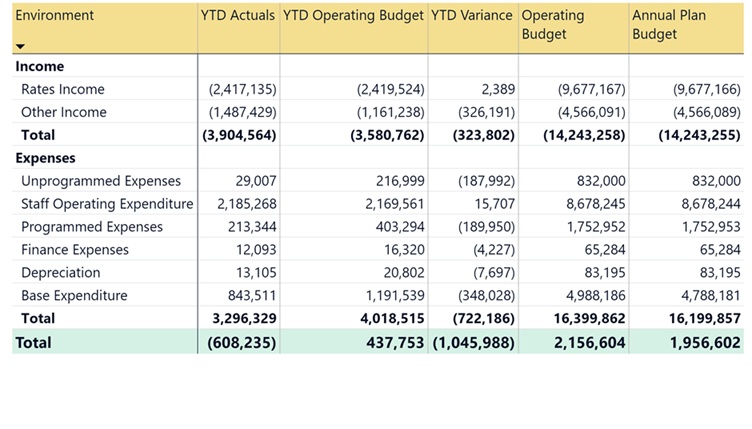
Notes
· The ‘Total
Operating Budget’ differs from the ‘Total Annual Plan Budget’
in that it includes carry forwards and reallocations made after the final
approval of the Annual Plan.
· Base expenditure
is expenditure that happens year after year, for example yearly contracts or
operating expenses.
· Programmed
Expenditure is planned work, or there is a specific programme of works. For
example, painting a building.
· Unprogrammed
Expenditure is reactive or unplanned in nature, for example responding to a
weather event. Budgets are included as provisions for these expense which are
unknown.
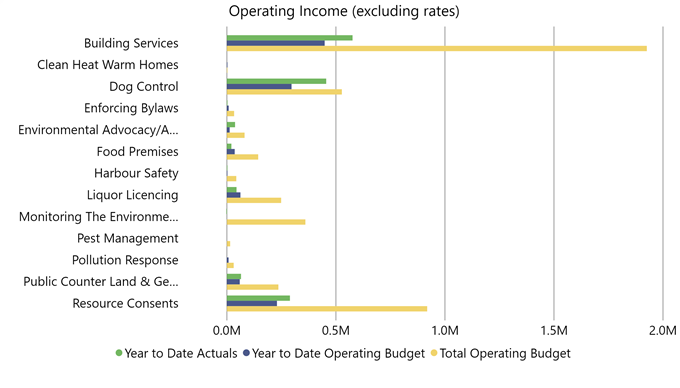
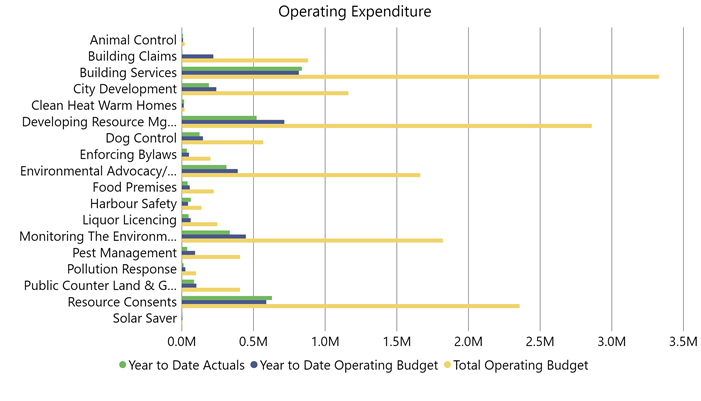
Variance Commentary
Monitoring the Environment expenditure is behind budget by $107,000 in Q1 due to the Hill Country Erosion programmed
expenses ($42,000), Healthy Streams programmed expenses ($23,000), Estuary
health investigation work ($15,000), and Hydrology monitoring ($14,000) works
not occurring until Q3 and Q4.
Pest Management expenditure is behind budget by $55,000 due to an invoice not
being received from Tasman District Council for Providing Biosecurity expenses
($48,000) for Q1, these are also due to be paid in Q2, Q3 and Q4.
Developing Resource Management Plan expenditure is behind budget by $189,000 as work on the Nelson
Plan during Q1 has been largely staff time preparing for the public
engagement. Further technical work and requirements will be undertaken in
Q3 and Q4 utilising the budget.
Environmental Advocacy expenditure is behind budget by $79,000 mainly due to budget
phasing in Nelson Nature ($95,000 behind budget).
Dog Control income is ahead
of budget by $159,000 due to budgeting monthly over the financial year,
whilst the bulk of the dog registrations came in during this quarter.
Registration fees were moved to September for payment and will be reported in
the next quarterly report.
Building Services income is ahead
of budget by $128,000 due to building consents being higher than
anticipated ($97,000) as budget assumed reduced activity following COVID-19
lockdown
Building Claim expenditure is behind budget by $217,000. This relates to a provisional claim
of $217,000 for a leaky home which is budgeted in 2020/21 but has not been paid
as at 30 September 2020. The claim is funded by reserves.
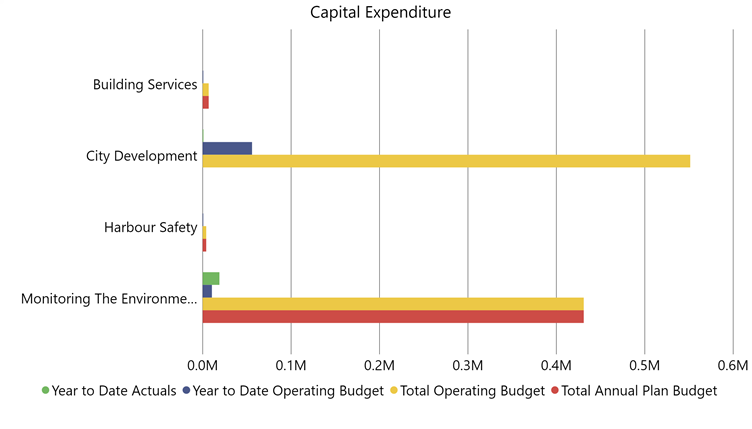
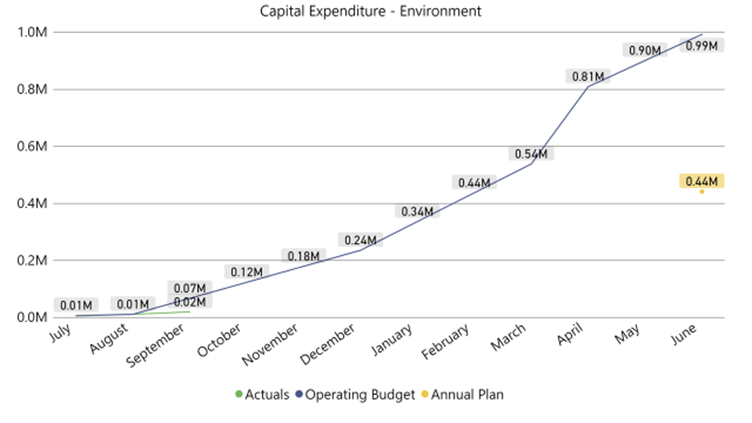
Key Performance Indicators
4.1 The Environment Management Group is on track
to meet most of its performance measures. The measure for resource
consents being processed within 20 working days is at 99% rather than
100%.
4.2 The dog and animal control, and pollution
response measures are difficult to report as there are some technical issues
with the reports where the system is unable to differentiate working and
weekend days. Officers are currently working on this issue to rectify
this issue.

Summary of activities
4.3 The Building team is no track to
meet its performance measures. There have been no breaches to the 20-day
timeframes in both Consents Granted and Code Compliance Certificates
issued.
4.4 The
City Development team has been focusing on the Streets for People options,
population projections and the Intensification Action Plan. The Pop Up
Park also opened mid-September and has proven very popular.
4.5 The Planning team’s major
focus has been the draft Nelson Plan which was made public for consultation on
6 October 2020. Staff are continuing to
prepare technical work needed to support the development of the incomplete
sections of the draft Plan.
4.6 More
alcohol licensing inspections and food verifications have been
undertaken than the same time last year to catch up on inspections from
lockdown. All other environmental health regulatory functions are on
track to meet targets. Resource consent
compliance timeframes are averaging 99% for the first quarter with two consents
out of 124 consents not meeting the statutory timeframes.
4.7 A
milestone has been reached with the Warmer Healthier Homes Nelson Marlborough
Tasman Project insulating its 2,000th home. The annual report
has been received and attached (A2502472).
4.8 The August round of the
Environmental Grants Scheme has been undertaken with $270,000 being awarded for
various activities. The next round will occur in February 2021.
4.9 The
Government’s ‘Jobs for Nature’, COVID-19 recovery package has
resulted in $3.7 million of funding comprising $2 million from the Department
of Conservation and $1.7 million from the Ministry for the Environment
(Mfe). This programme will create the equivalent of 51.5 FTEs (21.5 FTEs
split over five years and 30 FTEs over two years) for the Nelson region along
with significant environmental restoration benefits.
4.10 Consideration
is also being given to the proposed management, implementation, and monitoring
requirements for freshwater under the National Policy State – Freshwater
(NPS-FM) and biodiversity under the draft National Policy Statement for
Indigenous Biodiversity (NPS-IB). These NPSs are likely to significantly
increase the statutory requirements relating to the management and protection
of freshwater and indigenous biodiversity.
Legal Proceedings Update
Building
4.11 A notice was issued in July 2012 that determined an
unreinforced masonry building to be earthquake prone. A deadline
completion of seismic work was set, to render the building ‘not
earthquake prone’. No engineering assessment has been provided and no
work has started on the building.
4.12 As a consequence, notice of intention to seek a Court
order to carry out seismic work under section 133AS(3) of the Building Act 2004
and seek recovery of costs was sent to the building owner on 19 May 2020.
The Court accepted the application for orders and served it on the building
owner in mid-October 2020. An initial call over date has been set for 19
November 2020.
4.13 There are currently three further legal proceedings
sitting with the Building team and these are being managed by Council’s
appointed legal counsel. These are being reported to the Audit and Risk
Subcommittee.
Resource Consents and
Compliance
4.14 A Financial Assessment Hearing for the payment of
costs associated with Court proceedings taken in relation to a dog control
matter resulted in a decision that the monthly payments were to increase. This
has not occurred by the date it was due to commence. A prosecution for
another dog attack is taking a similar approach with a hearing on 2 December
2020.
4.15 Environment Court mediation resulted in agreement by
the parties for remedial work on two neighbouring properties. The remediation
follows a slip caused by unauthorised earthworks. Enforcement orders have
been issued, building consent has been granted and resource consent lodged for
the additional works. There is an appeal on the decision to vary the original
consent that should be easily resolved now agreement has been reached for the
additional works.
Risks and Challenges
Building
4.16 Recruitment in specialist roles is a real
challenge at the moment due to a national shortage of skilled Building Control
officers. The Team Leader Building Inspection role has been vacant since 11
February 2020 despite numerous recruitment attempts.
City Development
4.17 Upper Trafalgar Street multi-function pole fabrication
and catenary lights have been delayed due to design and importing
timelines. This will now take place in the New Year.
4.18 The
NPS Urban Development requires cross territorial authority boundary work to
develop the Housing and Business Capacity Assessment and review of the Future
Development Strategy. This work contains numerous risks and challenges as
the two councils have different levels of resourcing and budget, different
deadlines and priorities.
Planning
4.19 The Government has signalled changes to the Resource
Management Act with significant reform within the period of the development of
the Nelson Plan. Staff are keeping a close eye on the content and timing of
these reforms and will report to Council on any implications.
4.20 The Nelson Plan programme also needs to consider the
timing of the release of further National Policy documents (e.g. NES Air
Quality; Highly Productive Land; and, Indigenous Biodiversity). Staff
anticipate receiving an updated work programme from Mfe in the latter part of
this year, with associated timeframes for release of national directions.
Resource Consents and
Compliance
4.21 The auditors identified some LTP measures as not
meeting their reporting requirements for dog and animal control, food safety
and public health, alcohol licensing and pollution response measures. A
new report has been introduced that enables the capturing of data for the dogs
and animal control, and pollution response measures, however there is a high
likelihood these measures will not be met due to the report’s inability
to differentiate between week and weekend days. Measurement reporting
mechanisms are still not available for food safety and alcohol licensing.
Officers are working to rectify these issues.
Science and Environment
4.22 The implications of the updated National Policy
Statement for Freshwater (NPS-FM), and the National Environment Standard for
Freshwater (Freshwater NES) are being assessed by officers. Consideration is
also being given to the draft National Policy Statement for Indigenous
Biodiversity (NPS-IB).
5. Climate
Change
5.1 Council has undertaken a wide range of climate change
activities during this period. Steps to reduce emissions include adopting
emissions reduction targets in August 2020, with work now underway to develop a
draft Emissions Reduction Action Plan by December 2020.
5.2 The local “Businesses for Climate Action”
group has been supported, with $28,880 funding from the Climate Reserve, to
help businesses to identify and reduce emissions. The Climate Reserve has
also supported the purchase of an electric bike and trailer for
“Community Compost” to collect suitable waste.
5.3 A Council-wide energy management programme is being
developed to determine where energy/cost gains can be achieved. An energy audit
of Civic House was completed in July, identifying that cost savings of up to
50% per year, and carbon reductions of up to 63,000 kg (carbon-dioxide
equivalent) could be achievable when the building upgrade occurs. Additionally,
Council owned indigenous or retired plantation forests are being assessed for
their ability to earn carbon credits: results are expected by the end of 2020,
with the potential to apply to MBIE for carbon credits.
5.4 Coastal and flood hazard risk maps and engagement
material have been prepared for consultation alongside the Nelson Plan in
November. The development of an appropriate framework and work programme for
climate adaptation is underway. This will focus on undertaking
appropriate risk and vulnerability assessments as well as engaging with the
community and building on the consultation undertaken for the Nelson Plan.
5.5 Officers are meeting to co-ordinate and communicate on
climate change work across the Council. A step change has been seen in climate
change consideration of the Activity Management Plans for the LTP, as well as
the Infrastructure Strategy.
5.6 Officers have also been active in sharing
Council’s climate change work across the country. This has also
included formalising aspects of cross-council collaboration nationally in
conjunction with LGNZ and Mfe.
5.7 Council continues to support and encourage the work of
the Nelson-Tasman Climate Forum (with $90,000 from Council funding). Actions
and a strategy are being developed to reduce emissions and increase resilience
to climate impacts.
6. Environmental
Management Activity Update by Business Unit
Building
Achievements
6.1 The Building team is on track to meet its
performance measures. The building team has achieved no breaches to the
20-day timeframes in both Consents Granted and Code Compliance Certificates
issued.
Trends
|
|
2020-21 1st Quarter
|
2019-20 1st Quarter
|
|
Building Consents and amendments
|
226
|
305
|
|
Code Compliance Certificates
|
162
|
215
|
|
Inspections
|
1955
|
1343
|
|
LIMs
|
203
|
140
|
6.2 The sharp increase in building inspections
(1955) can be partly attributed to the new database “Go Get” which is
more accurately collating the data. The previous consents database
“Alpha” never fully collated the correct number of consents being
inspected.
6.3 Land Information Memorandums (LIMs)
applications have increased significantly. There were no breaches of the
10-day statutory timeframes despite the increase.
Strategic Direction and Focus
6.4 The construction sector is busy
with a number of larger construction projects underway including the Malthouse
Lane and Ocean View apartment buildings, and the retirement villages at
Summerset and Coastal View. A potential downturn due to COVID-19 has not
eventuated.
6.5 In 2021, both the Building
Consent Authority (BCA) and the Territorial Authority (TA) will be audited by
IANZ and the Ministry of Business, Innovation and Employment (MBIE)
respectively. Officers are preparing for these visits with a particular focus
on the compliance area for the bi-annual audit by the MBIE.
6.6 Engagement is underway with the
consenting system provider. This will further develop and streamline
processes and technology to gain some building unit efficiencies.
City Development
Achievements
6.7 The Pop Up Park was opened mid-September. Since
September, the door from the library and CCTV cameras have been
installed. The park is very popular and it has been great to see
increased numbers of tamariki in the city centre.
6.8 Streets for People city centre place making options
were deliberated on and a decision to align the project with the Spatial Plan
and Parking Strategy was made. Officers are now working on project
planning and will be bringing an update to Council shortly.
6.9 Custom population projections have been developed to
take into account the impacts of COVID-19. These will be reported to
Council on 12 November 2020 for adoption.
6.10 The Intensification Action Plan was adopted by Council
on 22 September and officers are now giving effect to the operational
actions. A report outlining options for Council in housing supply will be
presented at a future meeting.
6.11 The Mayoral Liaison team for the Future Development
Strategy met on 16 October. Officers of Nelson and Tasman councils have
prepared a report to the Joint Committee on 10 November providing an update and
decision on the urban environment for the review of the Future Development
Strategy.
6.12 The Urban Design Panel is meeting in October to review
three intensification projects. Officers have reviewed these and have
been providing guidance to applicants on housing intensification projects.
Strategic Direction and Focus
6.13 The
key strategic focus of the City Development team is to complete:
· The City Centre Spatial Plan by mid-2021 alongside the
Parking Strategy to help inform Streets for People place making and the Long
Term Plan.
· The review of the Development Contributions Policy so
it can be updated with the LTP.
· The Housing and Business Capacity Assessment required
under the National Policy Statement – Urban Development ready for
adoption by 31 July 2021.
6.14 Officers
are continuing to work on implementing the Intensification Action plan.
They are also working to build developer relationships and leverage greater
investment in housing.
PLANNING
Achievements
Draft Nelson Plan Preparation
for Public Engagement
6.15 The
focus for the quarter has been preparing the Draft Nelson Plan (the Plan) and
associated E-plan for release to the wider public in early October. From
June, the Planning team processed feedback from early engagement with key
stakeholders; and conducted a series of workshops with Councillors to outline
the approach taken in the Plan to key issues.
6.16 Associated with the release of the draft Plan is a
large volume of information and engagement material. These were prepared to
assist the public’s understanding of the Plan, and changes from the
Nelson Resource Management Plan. Officers are continuing to complete technical
work needed to support the development of the incomplete sections of the Plan.
6.17 During September staff also prepared three reports to
Council. The first report provided an update on timeframes for preparing the
Plan; the second report sought approval to release the Plan for feedback; and
the third was an update on the work of the Plan and iwi working group progress.
6.18 In addition, the team worked to understand and start
to implement two new National Policy Statements (NPS). These were the NPS for
Freshwater Management (and associated Healthy Waterways Package) and the NPS
Urban Development.
Urban Environment Bylaw
6.19 The Urban Environment Bylaw is in the process of being
reviewed, in accordance with the Local Government Act 2002. The next step
is to consider options for the scope of the review.
Nelson Tasman Land
Development Manual (NTLDM)
6.20 In September, a report to Council outlined the need
for some minor changes to the NTLDM. These changes will be completed in the
following quarter.
Strategic
Direction and Focus
6.21 The focus for the remainder of the year will be on
producing the Draft Nelson Plan for the second round of public engagement;
undertaking engagement; and continuing to work on areas of the Plan that remain
incomplete, including the mapping of flood and coastal hazards.
RESOURCE
CONSENTS AND COMPLIANCE
Achievements
6.22 Resource consent compliance timeframes are averaging
99% for the first quarter with two consents out of 124 consents not meeting the
statutory timeframes. Some of the consents issued in the first three months of
the financial year were the subdivision of rural zoned land into 16
residential-sized lots, locating all of the Bay Dreams event on Rutherford Park
and discharge consents for the fumigation process at the Port.
6.23 The Dog Control Activity Report for the 2019/20 year
as required by Section 10A of the Dog Control Act 1996 has been produced and
submitted to the Department of Internal Affairs (attached A2488765). There have
been some very positive trends, the number of registered dogs has been
increasing despite there being more dogs. Complaints received relating to
dog activity has also decreased year on year.
6.24 The deputy harbourmaster has extended the popular
Women on Water safety workshop to a Mums and Kids version which was well
attended. The harbourmaster hosted the South Island Harbourmasters meeting. A
combined Nelson and Tasman regional oil spill exercise was attended by Maritime
NZ assessors and received positive feedback.
Trends
6.25 The
total number of parking infringement notices are about half that of the same
period last year. An educational approach was taken due to the
installation of the new parking meters. The Government also extended
vehicle licencing and warrants of fitness to October 2020 which led to less
infringement notices.
6.26 There
have been more alcohol licensing inspections and food verifications than the
same time last year to catch up on inspections from the COVID-19 lockdown. The
rest of the regulatory activity levels are similar to last year.
Strategic
Direction and Focus
6.27 Officers are participating in regional and national
forums to provide consistency on how the new Policy Statements and
Environmental Standards are implemented. There are likely to be
significant implications for Council.
SCIENCE
and ENVIRONMENT
Achievements
Air Quality
6.28 The Science and Environment team is on target to meet
the air quality performance measures. There were no exceedances of the
National Environmental Standards for Air Quality (NESAQ) during this quarter.
Warmer Healthier Homes
6.29 The Warmer Healthier Homes Nelson Marlborough Tasman
Project celebrated insulating its 2,000th home in the region. The annual report
for the year 1 July 2019 to 30 June 2020 has been received September 2020 and
attached (A2502472).
6.30 The Warmer Healthier Homes project supports residents
in the Nelson, Tasman and Marlborough regions to improve living
environments. It assists homeowners and their whanau by installing
insulation measures, heating and increasing overall efficiency through
retrofitting existing homes. Over 2,200 homes have been insulated across
the Top of the South since the project’s inception in 2014.
Healthy Streams
6.31 The North Branch hydrometric site above the reservoir
has been upgraded. A new telemetry, water level sensor and continuous
dissolved oxygen and temperature logger have been installed.
6.32 Cyanobacteria levels were low across all Nelson rivers
and streams during this quarter. Additional signage will be
installed at Isel Park where moderate levels (20% cover) occurred over summer
and winter.
6.33 Bully fish spawning surveys were initiated in
September focusing on Stoke streams, particularly those with high densities in
the lower reaches of Poorman Valley Stream. A project is underway with GIS and
the draft Nelson Plan teams to map fish spawning habitat.
6.34 Otago University, Manaaki Whenua Landcare Research and
Cawthron began working collaboratively with Council to profile reservoir water
and sediment for nutrients and diatoms. The surveys are in preparation for
aerating the reservoir to promote mixing and maintaining excellent water
quality year-round.
6.35 A “How to clean paint brushes and dispose of
paint water” brochure was produced. This has been distributed
to businesses selling paint to the DIY market.
6.36 A community engagement project for Poorman Valley
Stream has been initiated. This project will run until December 2021 and
includes two community art projects, a field guide and a StoryMap.
6.37 Approximately 1000 plants have been distributed to the
community. These will be used for riparian planting where properties back
onto streams, primarily in the Stoke area.
Coastal and Marine
6.38 A broad scale habitat survey and report on the Waimea
Estuary (jointly with TDC) has been completed and is under review. Reporting
from the estuarine programme over the last two years was presented to
councillors at a workshop.
Nelson Nature Programme
6.39 Sixty-two applications were received in the August
2020 Environmental Grant round, requesting almost $500,000 of funding. $270,000
has been awarded from Council's Nelson Nature, Healthy Streams and Sustainable
Land Management programmes. The grants provided will help support landowners
and community groups to control weeds and animal pests; erect fences to protect
streams, protect Significant Natural Areas and bush fragments; manage erosion;
and plant over 35,000 native plants across the Nelson region. The next round
for Environmental Grants Scheme will be in February 2021.
6.40 The annual goat and deer control operation in the
Maitai and Roding Water Reserves was completed in September. The operational
area was expanded this year to include a larger part of the reserves, but
excluded highly visited tracks in the Maitai area. A full report is expected,
however early indications show less goats were found this year, and more deer
were encountered.
6.41 A scheme providing subsidised rat, possum and stoat traps
for Nelson residents to support Halo backyard trapping was initiated. The
subsidised traps are available to purchase at the DOC Visitor Centre. There has
been a good uptake from the community.
6.42 Nelson Nature commissioned a report identifying options
for restoring coastal ecosystems, including salt marsh, in the Waimea Inlet and
the Haven. These ecosystems are extremely rare within these estuaries and are
critical to their functioning. These are at risk of further loss due to
climate change effects. The report will be discussed with key
stakeholders and may lead to a restoration project. The report will be
circulated in the Councillor’s Newsletter.
6.43 Significant Natural Areas (SNAs) are sites identified
as holding particularly high biodiversity values. SNAs are scheduled under the
draft Nelson Plan and work has been completed this quarter to finalise their
mapping, arrange surveys, and respond to landowner enquiries.
Sustainable Land Management
Programme
6.44 Funding from the Ministry for Primary Industries has
been received by 27 landowners for the planting of native trees on steep
ex-forestry or pasture land, and a small portion of poplars on farmland.
A further seven landowners received funding from NCC for stock exclusion
fencing, and the planting of riparian streams and critical source areas to
improve water quality on productive land.
6.45 Over the last two quarters work has been under way
helping small landowners develop their forestry environment plans for the
management of future forestry or to transition plantation forestry to native
forest. The resources developed to date can be found here: http://www.nelson.govt.nz/environment/resources/
6.46 The Environment Committee requested an update (March
2020) on the Maitai Forestry Forum before the end of 2020. Due to
COVID-19 restrictions the Forum has not met. Further to this two key partners
withdrew from the Forum: Tasman Pine Forests Ltd and Ngati Koata. However,
work has been continuing and a full report on the Forum including background
and a table of potential actions is attached (A2379467).
Project Mahitahi
6.47 MfE has granted NCC $1.7 million for the terrestrial
restoration of the Maitai Mahitahi Catchment, to be undertaken over the next
five years. A Deed of Funding was signed at the end of September, and
discussions have been held with Nelmac to deliver this work. The
equivalent of 21.5 FTE (split over 5 years) will be employed to undertake the
workplan and will be overseen by NCC staff from both Science and Environment
and Parks and Facilities. A 0.5 FTE Project Manager has also been funded
based at NCC.
6.48 At the end of September, DOC announced a further grant
of $2 million to NCC to support Project Mahitahi. This funding is through
Kaimahi for Nature, and was approved through the Kotahitanga mo te Taiao
Alliance. This funding enables a further 30 FTE roles over two years.
6.49 Project Mahitahi is co-designed and co-delivered with
iwi partners. The Project Governance Group has representation from
Council and three of the iwi partners through the Alliance: Ngati Koata, Ngati
Rarua, and Te Atiawa.
6.50 The combined projects will see the planting of 125,000
native trees in the catchment with community partners, managing 24 ha of pest
plant and animal control, and the further planting of 2 ha of wetland areas.
Biosecurity
6.51 A successful trial removal of the pest Mosquito fish
Gambusia has been undertaken with DOC in the intertidal reaches of Maire stream
at the Nelson Golf course. Over 180 Gambusia were removed over two months. The
trial will inform a collaborative strategy for managing Gambusia within the
Moutere-Waimea estuaries.
Environmental education
6.52 Hira Rural Kindergarten is now a Green-Gold
Enviroschool. This is the first kindergarten in Nelson to achieve this.
6.53 A Step into Spring active travel challenge has been
run with seven schools. Students were challenged to travel by foot, bike,
scooter or skateboard for two weeks. Stamps were issued in passports when they
used active transport methods to school. Spot prizes and pop up days encouraged
continuous participation, aiming to get families to change habits.
6.54 Victory Primary School finished the Drains to Harbour
programme. It created a book, posters, and short film showcasing the learning
and encouraging its community to look after the local awa.
Heritage Project Fund
2020/2021
6.55 35 applications were received for this year's Heritage
Project Fund round (August 2020) seeking $357,910. 19 were successful and
$91,523 allocated.
Strategic
Direction and Focus
6.56 A Coastal and Marine Scientist position will be
focussing on the Coastal and Marine monitoring programme. This role will
also undertake further engagement with key stakeholders regarding Tasman Bay.
6.57 Planning is underway to respond to the updated NPS-FM,
and the Freshwater NES. These policies contain additional monitoring,
implementation requirements for the Science and Environment team.
6.58 Consideration is also being given to the proposed
management and monitoring requirements for biodiversity under the draft NPS-IB.
This NPS is likely to significantly increase the statutory requirements on
regional councils relating to the monitoring management and protection of
indigenous biodiversity.
Author: Clare
Barton, Group Manager Environmental Management
Attachments
Attachment 1: A2497007 -
Building and Consents and Compliance statistics ⇩
Attachment 2: A2508033
- Project sheets - 2020-21 Environmental Management Quarterly Report - 1st
Quater ⇩
Attachment 3: A2497431
- 2020-21 Environment Committee Quarterly Report ⇩
Attachment 4: A2379467
- Maitai Forestry Forum Summary of work to date ⇩
Attachment 5: A2508060
- Q1 Environment - 2020-21 - Performance measures ⇩
Attachment 6: A2502472
- Warmer Healthier Homes Annual Report ⇩
Attachment 7: A2488765
- Dog Control Activity Report 2019-2020 ⇩
|
Important considerations for decision making
|
|
1. Fit
with Purpose of Local Government
Section 10 of LGA 2002 requires local government to
perform regulatory functions in a way that is most cost-effective for
households and businesses. This quarterly report identifies the performance
levels of regulatory and non-regulatory functions.
|
|
2. Consistency
with Community Outcomes and Council Policy
The Council’s Long Term Plan includes performance
measures for various activities and this report enables the Council to
monitor progress towards achieving these measures.
The Environmental Management work programme addresses the
following community outcomes:
· Our unique
natural environment is healthy and protected.
· Our urban
and rural environments are people friendly, well planned and sustainably
managed.
· Our infrastructure
is efficient, cost effective and meets current and future needs.
· Our
communities are healthy, safe, inclusive and resilient.
· Our
communities have opportunities to celebrate and explore their heritage,
identity and creativity.
· Our Council
provides leadership and fosters partnerships, a regional perspective, and
community engagement.
· Our region
is supported by an innovative and sustainable economy.
|
|
3. Risk
Increased national direction (National Policy
Statements) has the potential to impact on work programmes, budgets and
statutory timeframes.
|
|
4. Financial
impact
Currently behind budget on all of our
activities. No further financial implications.
|
|
5. Degree
of significance and level of engagement
This matter is of low significance and no engagement
has been undertaken.
|
|
6. Climate
Impact
The provision of regulatory and non-regulatory
services directly assists Council to take appropriate action or advocate for
others to take action to address the impacts of climate change.
|
|
7. Inclusion
of Māori in the decision making process
No consultation with Māori has been undertaken
regarding this report.
|
|
8. Delegations
The Environment and Climate Committee has the
following delegation:
Areas of Responsibility:
· Building control matters, including earthquake-prone
buildings and the fencing of swimming pools
· Brook Waimarama Sanctuary Trust
· Bylaws, within the areas of responsibility
· Climate Change policy, monitoring and review
· Climate change impact and strategy overview -
mitigation, adaptation and resiliency
· Climate change reserve fund use
· Environmental programmes including (but not limited
to) warmer, healthier homes, energy efficiency, environmental education, and
eco-building advice
· Environmental regulatory and non-regulatory matters
including (but not limited to) animals and dogs, amusement devices, alcohol
licensing (except where delegated to the Alcohol Regulatory and Licensing
Authority), food premises, gambling, sugar-sweetened beverages and smokefree
environments, and other public health issues
· Environmental science monitoring and reporting
including (but not limited to) air quality, water quality, water quantity,
land management, biodiversity, biosecurity (marine, freshwater and
terrestrial), pest and weed management, and coastal and marine science
· Environmental Science programmes including (but not
limited to) Nelson Nature and Healthy Streams
· Hazardous substances and contaminated land
· Maritime and Harbour Safety and Control
· Planning documents or policies, including (but not
limited to) the Land Development Manual
· Policies and strategies relating to compliance,
monitoring and enforcement
· Policies and strategies related to resource
management matters
· Pollution control
· Regulatory enforcement and monitoring
· The Regional Policy Statement, District and Regional
Plans, including the Nelson Plan
· Urban Greening Plan
Delegations:
The committee has
all of the responsibilities, powers, functions and duties of Council in
relation to governance matters within its areas of responsibility, except
where they have been retained by Council, or have been referred to other
committees, subcommittees or subordinate decision-making bodies.
|



















































































































